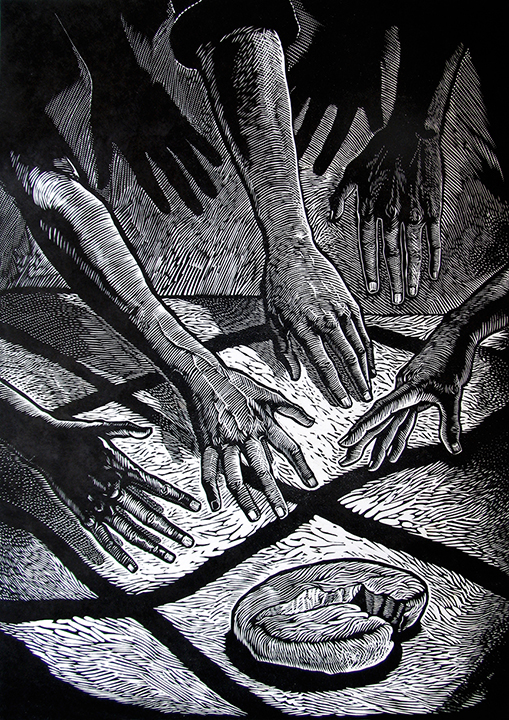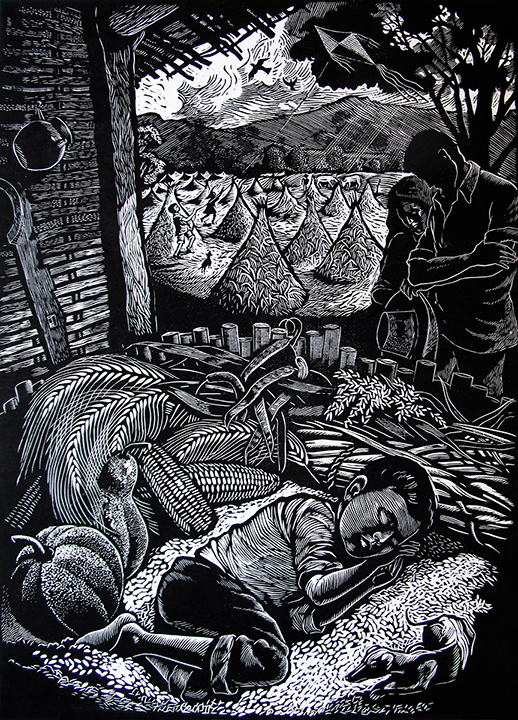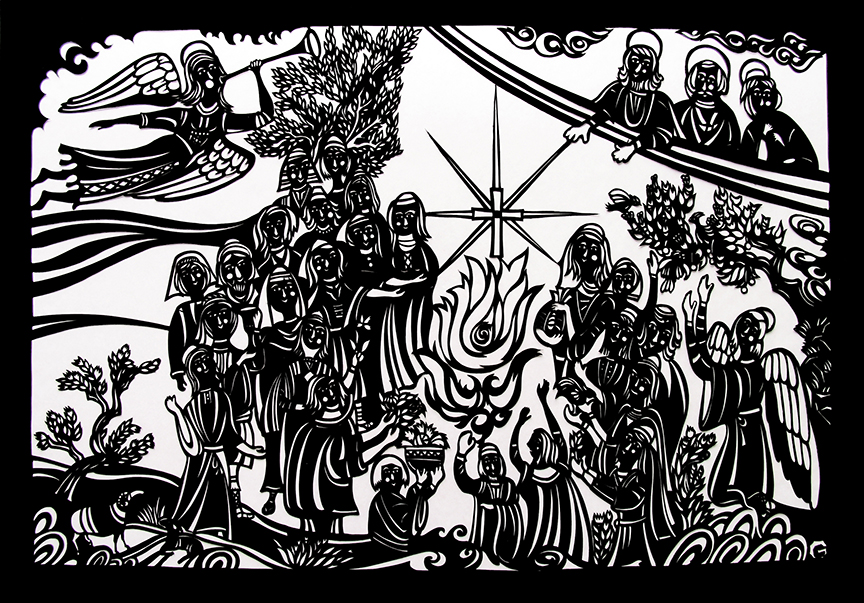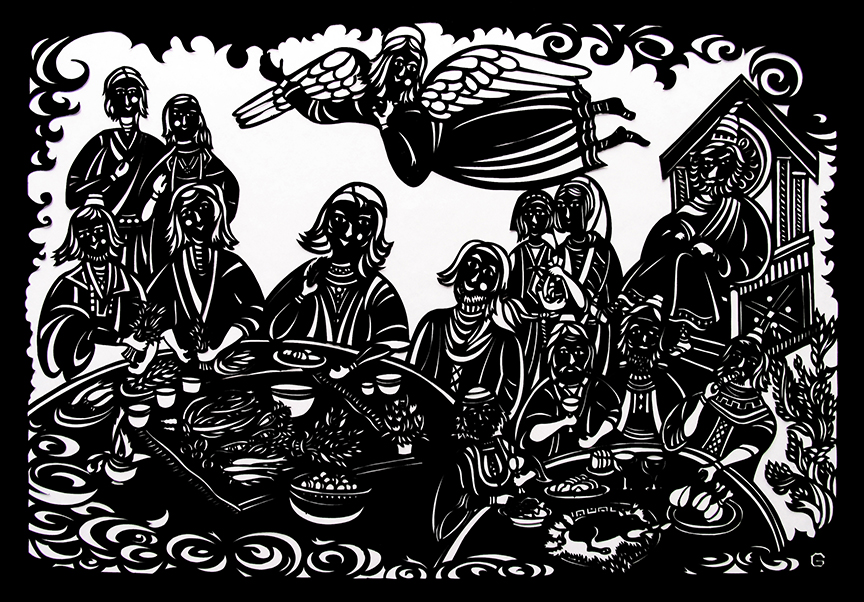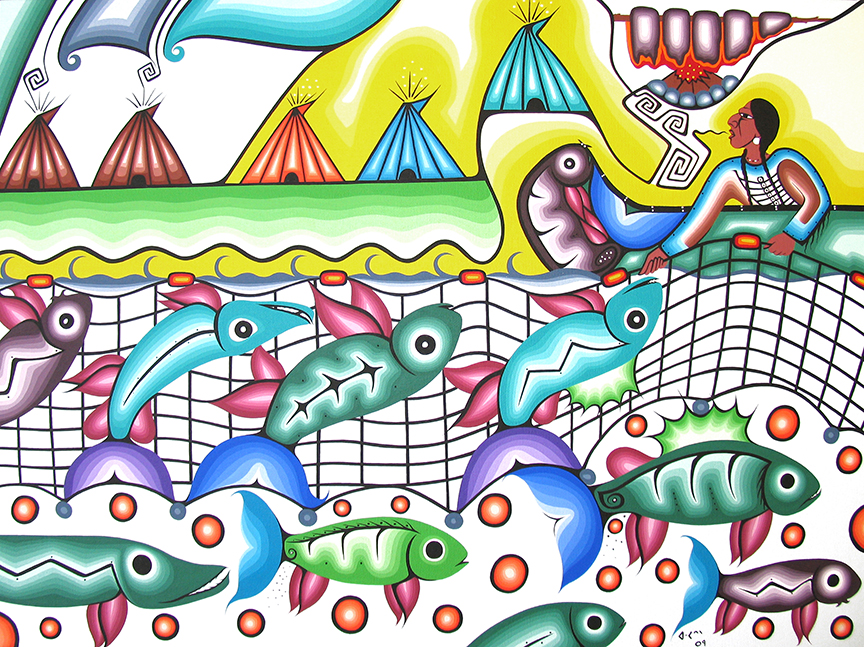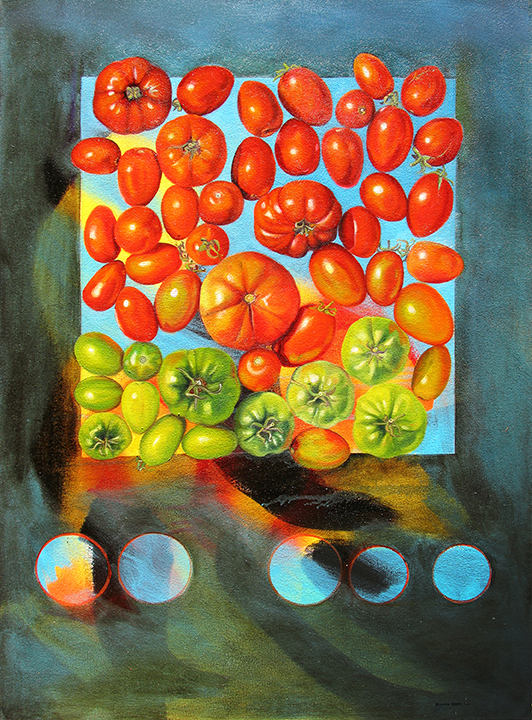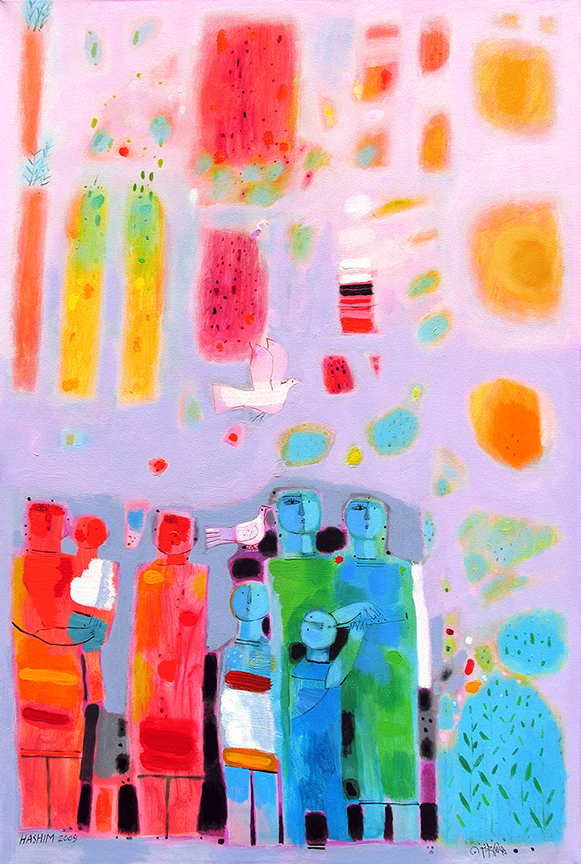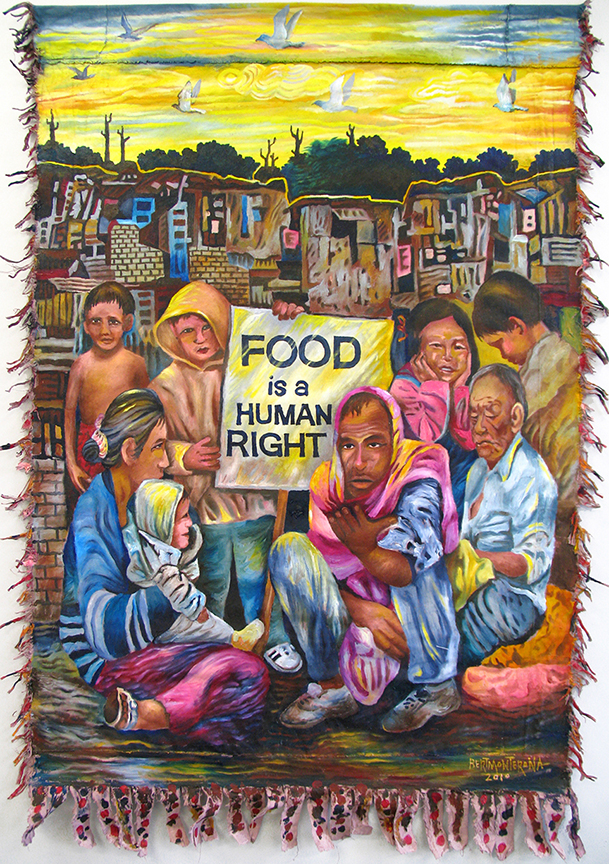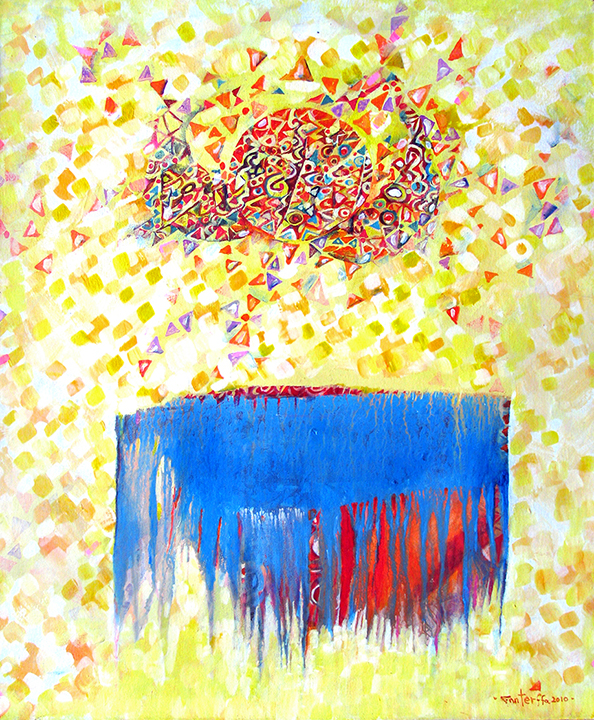The Just Food exhibition explores the right to food, and was created by the Mennonite Committee on Human Rights, based out of Winnipeg, Manitoba.1
Eighteen commissioned artists from Canada and around the world were asked to interpret the meaning of the human right to food in two pieces of original art specifically created for this exhibition. The artists were divided into six groups of three, with one Canadian and two international individuals in each group. The groups were asked to create artistic responses to two different texts—six human rights declarative texts each paired with a different passage from the Old Testament.2
The artists represented a wide range of cultural, economic, and faith backgrounds. One artist, Jossias Sitoe from Mozambique, lived on the street when he was a child. The content of his art comes from a place of having known extreme hunger and need. Alejandro Aranda has worked on behalf of marginalized groups in one of Mexico’s poorest states, Guerrero, for years. Bert Monterona is motivated by justice issues in his Philippines homeland. Tibebe Terffa was imprisoned, tortured, and deprived of food under the previous Mengistu dictatorship in Ethiopia. Isam Aboud comes from the Sahara Desert of northern Sudan, where temperatures hit fifty degrees Celsius in the summer. He knows the harshness of an unforgiving climate. Hashim Hannoon, a refugee from Iraq, knows the affect war has on food production and security. Annelies Soomers is a Dutch artist who has advocated for the least among us for years through her art. Jairo Alfonso Castelanos, from Cuba, understands what it’s like to live with ration cards. Ovid Charlette is a First Nations person of Canada, and discovered his artistic talents in prison. From a rich traditional base, he explores important issues with pain, skill, and raw openness.
The art presented in this exhibit challenges viewers to discover, contemplate, and explore food-related issues from a myriad of cultural, faith, political, and economic perspectives, sometimes in literal terms, sometimes more abstractly, some holding close to the quotes, some unveiled with broader brush strokes, but all created with integrity using the universal language of art.
Just Food exhibit sponsors included Mennonite Central Committee Canada, Canadian Foodgrains Bank, Canadian International Development Agency, Friends of the Mennonite Centre in Ukraine, and Mennonite Heritage Centre Gallery, among others.
Image 1: Alejandro Aranda. La Búsqueda (The Search).
Sources of inspiration
Universal Declaration of Human Rights, Article 25
“Everyone has the right to a standard of living adequate for the health and
well-being of himself and of his family, including food, clothing, housing
and medical care and necessary social services.”
Adopted by the General Assembly of the United Nations, 10 December, 1948
Amos 5: 11-12, 14
“You trample the poor, stealing their grain through taxes and unfair rent. Therefore, though you build beautiful stone houses, you will never live in them. Though you plant lush vineyards, you will never drink wine from them.
For I know the vast number of your sins and the depth of your rebellions. You oppress good people by taking bribes and deprive the poor of justice in the courts.
Do what is good and run from evil so that you may live! Then the Lord God of Heaven’s Armies will be your helper, just as you have claimed.”
(New Living Translation)
Image 1. Alejandro Aranda. Mexico, La Busqueda (The Search), 2010. Linocut, 20 x 28 inches. Artist copyright.
Author’s reflection
My hands, your hands: our hands interconnect, brown, white, black and yellow. Weathered, hard & callused, tired and worn out hands, constantly moving, offering and working, looking for tortillas, wheat and rice. Hands that plough the land; hands that with every seed plant life into the centre of the earth. Hands that water and care for the fruits. Hands in solidarity that share, help, teach; that build a better world. Hands that don’t close in fists in order to punch, that don’t pull the trigger to kill, that don’t sign the papers for war, that don’t contaminate the air, the land, the water. Hands that don’t hurt others because of ideology, belief, prejudice or the color of one’s skin. Yes to the hands that come together as brothers and sisters, those who struggle together for the common good, those who organize in the face of misfortune, those who rise up before injustice, who give spirit and hope. Yes to those who place a hand on your shoulder and encourage others to keep going, who suggest that it is possible to live in a world that is different, to live in a world without hunger or thirst.
Image 2. Alejandro Aranda. La Oración (The Prayer).
Sources of inspiration
Universal Declaration of Human Rights, Article 25
Amos 5: 11-12, 14
Author’s reflection
In el troje or the barn, my feet feel the corn. I step on the corn, sink and get lost in the corn. Jumping I make pirouettes and lie down and dream that I am the corn. A child of the corn: made of corn meal, color of a tortilla. I leave with my kite tied to a string of stars, the backbone of a giant animal. Above the moon is serene.
Author’s reflection
When nets are full and the community united, times are good, but beware of what lurks, of that which can break us.
Image 6. Rhonda Harper Epp. Bringing it Home: Tomatoes.
Sources of inspiration
Author’s reflection
We live in an awkward way; we import produce from warmer climates and pave over the most arable land in Alberta. We live with an uneasy knowledge of what that is doing to land, water and human resources in those warmer places, and with a futility of purpose in trying to counter economic forces that want industrial corridors not food production.
Author’s reflection
In this painting there is a family celebrating the harvest. In addition the coloured spaces, figures and other geometrical shapes represent a city. The happiness of the children makes them fly and play.
Image 8. Margruite Krahn. Soup and Pie.
Sources of inspiration
Author’s reflection
Author’s reflection
Philippines is a rich country in natural resources but millions of people are very poor. The wealth of the Nation is not equally distributed, the rich become richer and the poor become poorer. The leaders are corrupt, the capitalists are exploiting the masses, and the rich hold most of the positions in the government and they own the businesses and industries that have always exploited the working class.
Image 10. Tibebe Terffa. Color of Celebration.
Sources of inspiration
Author’s reflection
Harvest, thanksgiving, joy and love. The story of Matthew 15: 29-35 is ‘just food’ to me.
Footnotes
Ray Dirks is the Mennonite Heritage Centre Gallery curator. The gallery is a self-funded program of Mennonite Church Canada located on the campus of Canadian Mennonite University in Winnipeg, Manitoba.
The complete exhibit can be found at Mennonite Committee on Human Rights, Just Food Art, accessed June 14, 2015, http://justfoodart.com/.
